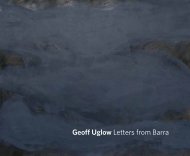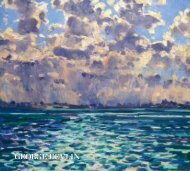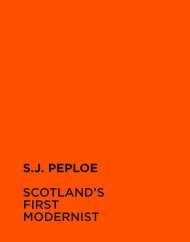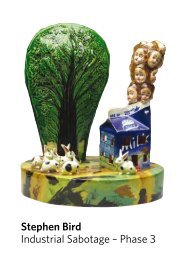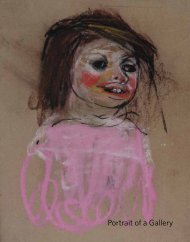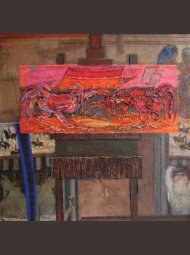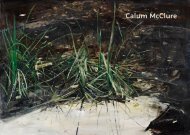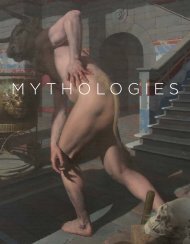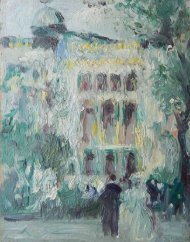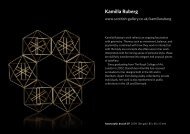Download a PDF of the exhibition catalogue - The Scottish Gallery
Download a PDF of the exhibition catalogue - The Scottish Gallery
Download a PDF of the exhibition catalogue - The Scottish Gallery
Create successful ePaper yourself
Turn your PDF publications into a flip-book with our unique Google optimized e-Paper software.
Walter Richard Sickert was born in Germany in 1860 and can be seen as one <strong>of</strong> <strong>the</strong> most influential British artists <strong>of</strong><br />
<strong>the</strong> 20th century. Sickert’s adoption <strong>of</strong> new and daring subject matter, twinned with a loose, suggestive handling <strong>of</strong><br />
paint directly influenced <strong>the</strong> Camden Town Group and <strong>the</strong> Euston Road School, as well as heralding many international<br />
developments <strong>of</strong> <strong>the</strong> 20th century. His subject matter included depictions <strong>of</strong> ordinary people in urban environments,<br />
music hall, <strong>the</strong>atre and <strong>the</strong> demi-monde <strong>the</strong>mes much influenced by his mentor Degas, who he had first met in Paris in<br />
1883. His adoption <strong>of</strong> social realistic subject matter, <strong>of</strong>ten with sexual undertones, had not been seen before in British<br />
art and was considered deeply shocking at <strong>the</strong> time.<br />
Sickert exhibited a series <strong>of</strong> paintings in <strong>the</strong> Leicester Galleries in 1937, based on 19th century illustrative<br />
engravings published in popular magazines, <strong>the</strong> sources <strong>of</strong> <strong>the</strong> painting <strong>of</strong>ten inscribed in <strong>the</strong> lower corner – as we see in<br />
this example <strong>The</strong> Holocaust, after Mary Ellen Edwards. <strong>The</strong>se ‘English Echoes’ as <strong>the</strong>y came to be known appeared to have<br />
little or no link with his earlier work. Some admirers <strong>of</strong> Sickert <strong>of</strong> were alarmed by <strong>the</strong>se seemingly static scenes and<br />
regarded <strong>the</strong>m as a decline in <strong>the</strong> painter’s artistic ability. However <strong>the</strong>y did enjoy success, examples being purchased by<br />
<strong>the</strong> Louvre and <strong>the</strong> National <strong>Gallery</strong>. By appropriating images from popular culture Sickert prefigures Pop Art by twenty<br />
years and emphasizes <strong>the</strong> ambiguity <strong>of</strong> <strong>the</strong> relationship between subject and viewer.<br />
Between 1930 and his death in 1942, Sickert’s paint texture grew drier, <strong>the</strong> application <strong>of</strong> it sparser and his<br />
engagement with his subject less direct, painting more and more from photographs. Lillian Browse, from whom Blyth<br />
bought several Sickerts from during <strong>the</strong> 1940s, did not like <strong>the</strong> later work; she remembers arguing with Blyth about <strong>the</strong><br />
matter. She recalled, “He liked <strong>the</strong> late Sickerts too; I didn’t, preferring <strong>the</strong> ‘rich juicy paint’ and we constantly used to<br />
tease and argue.” Although Miss Browse acknowledged that Blyth “was a passionate lover <strong>of</strong> Sickert and always adamant<br />
in his choice.”<br />
Walter Richard Sickert (1860–1942)<br />
<strong>The</strong> Holocaust after Mary Ellen Edwards, c.1937<br />
Oil on canvas, 71 x 46 cms<br />
Signed lower right and inscribed with title lower left<br />
Exhibited:<br />
Leicester Galleries, London, 1937<br />
Aitken Dott & Son, <strong>The</strong> <strong>Scottish</strong> <strong>Gallery</strong>, Edinburgh, 1942<br />
Literature:<br />
Wendy Baron, Sickert Paintings and Drawings, (Yale University Press,<br />
New Haven and London, 2006) p. 515, no. 659<br />
78



